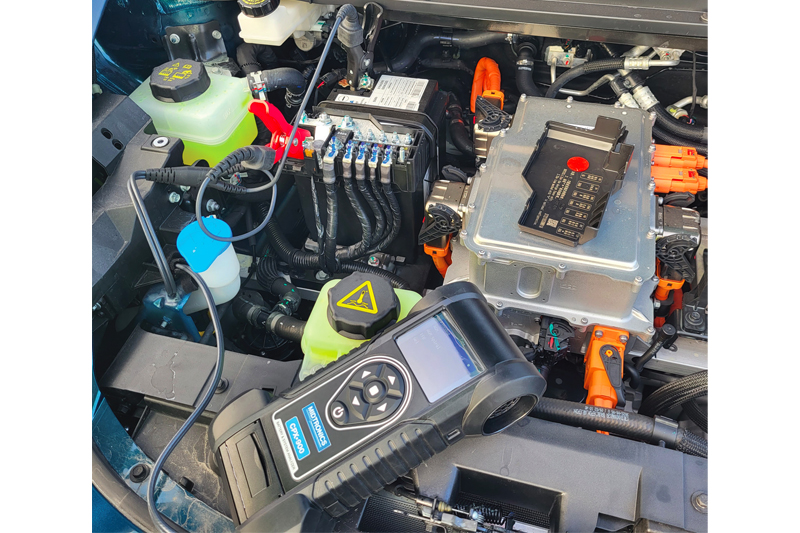
Ken Clark, managing director at Rotronics explains the difference between modern 12 V battery types and what causes can lead to battery drain.
It’s vital to know what battery type you are testing and charging, and what is the purpose of the battery. For example, if you have an EFB/AGM for a start/stop vehicle, you must test and charge appropriately or replace it like for like. It cannot be replaced with a standard flooded battery as this simply won’t work. You must know the difference in the technology you are dealing with.
There’s usually always a giveaway on the label, so it’s important to read them correctly. If it has state of charge indicator (SOCI) on it, it will only be a standard flooded or EFB battery. If it’s a start/stop vehicle, the battery can only be EFB or AGM.
There are several great battery manufacturer tools online that will tell you what battery technology is recommended for each vehicle application. All you need to do is submit the vehicle registration and you will get the battery information as required.
Different 12 V battery types
The most frequently seen option in any workshop are Lead Acid batteries. These include: Flooded, EFB, and AGM. More and more 12 V Lithium-ion batteries are appearing because of growing power requirements in vehicles, and the increased presence of EV/PHEV vehicles.
Tip: EFB, AGM, or Flooded batteries should be tested at every opportunity in a workshop. Lithium-ion batteries currently have no means of being tested as they have their own battery management system (BMS), however they should be charged with a compatible charger.
Lead acid batteries are used because of their cranking capacity. Start/stop, PHEV, or BEV vehicles need alternative technologies, to support the cycle and consumer demands of the vehicle’s electronics. These will generally be EFB or AGM batteries.
Lead Acid batteries such as Flooded, EFB, and AGM batteries can be tested using most conductance-based battery testers. However, not all testers are equal. The latest generation battery testing technology incorporates a controlled load to measure the battery’s “reserve capacity” (an essential component supporting start/stop and 12 V EV battery health diagnosis) along with future-proofing with wirelessly updatable testing software.
Lithium-ion 12 V batteries are a different kettle of fish. They are designed not to get to a critical level of discharge and the only way to return the battery to normal is by using a lithium-enabled charging product.
Tips to help your customers look after their batteries:
- Adopt regular battery maintenance throughout the year
- Be aware of changes in the electrics or the start-up
- Monthly charging will triple the life of your battery
- Charging technology is an important investment
Here are Rotronics’ Top 10 things that are most likely to drain your customers’ batteries. Most vehicles are packed with power-draining tech, so you and your customers need to be aware of the following and make sure that their vehicles are tested and charged appropriately.
- Self discharge: If a lead acid battery is sitting on a shelf, it can go from a fully charged state to chemically discharged in around eight months. Any stock batteries should be regularly charged each month.
- Continual power draw, when parked: A vehicle’s battery is still working hard, even when parked, to keep the clock, alarm, cooling systems going. Some vehicles get regular manufacturer updates and you may give instructions from your phone. This takes power form the battery.
- Opening doors: Each time a vehicle door opens, it springs into action, to disable the alarm and the locking system and lights go on. Just unlocking and opening a door and relocking will use around 50A from the battery. That has a daily toll.
- Leaving your key near the car: Don’t do this because the keys and the car talk to each other and for long periods of time, eg overnight, this will significantly drain on the battery.
- Too many short trips: Many short trips drain the battery. Just to get the vehicle started, it takes 150-350A of battery power and on short trips, the alternator has no opportunity to replace the charge.
- Parasitic drain: These are constant drains, and you have to make sure that everything is switched off when you leave the vehicle.
- Faulty alternator: The alternator helps charge up the battery and this process won’t work if the alternator is faulty.
- Chilly weather: When the temperature freezes, about 35 per cent in battery performance is lost. This can drop to 50 per cent loss in performance. It is important to stay attentive to any clues of a declining battery.
- Sulphation: Sulphation kicks in below 12.4V. Sulphate crystals build up, reducing the battery capacity, and the cranking ability. Sulphation accounts for 87 per cent of returned batteries under warranty claims and this can be avoided.
- Battery replacement needed: Ignoring the above hints and tips, will mean reducing the life of your battery and likely replacement. There will be geographical, weather and trip variations. Ultimately, the life of your battery could be reduced by two to three years without it being tested and charged.









